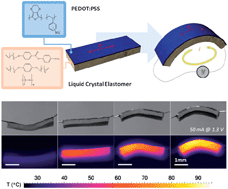Liquid single crystal elastomer/conducting polymer bilayer composite actuator: modelling and experiments†
Abstract
In order to integrate electroconductive properties in a Liquid Single Crystal Elastomer (LSCE) and to test direct actuation of the LSCE by Joule heating, we present a new bi-layered all-organic composite actuator based on the coupling of a nematic LSCE with a conductive polymer. The bending actuator is fabricated by depositing a thin conductive polymer layer of poly(3,4-ethylenedioxythiophene):poly(styrenesulfonate) (PEDOT:PSS) over the surface of a polysiloxane-based monodomain nematic LSCE film. Mechanical properties of PEDOT:PSS, better matched with LSCE ones compared with metals or inorganic nanoparticles used in other approaches, allowed us to develop an all-organic reliable millimetre-scale actuating composite. The thermally induced elongation/compression of the LSCE over 30% is exploited for the fabrication of bending actuators with curvature up to κ = 0.64 mm−1. The LSCE and the composite material are characterized as regards their thermo-mechanical and electrical properties. A model is introduced to describe bending of the composite as a function of the thermo-mechanical properties of the LSCE, and the model is assessed by comparing the model results with the experimental findings. Bending actuation via direct Joule heating of the composite is also assessed by supplying the necessary current (50 mA at 1.3 V) through wires connected to the composite. These results open new possibilities for the application of LCEs in the micro and soft robotics fields, as well as in the biomedical field.


 Please wait while we load your content...
Please wait while we load your content...